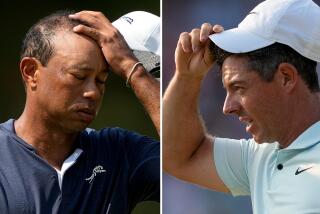Shakeup allows PGA Championship to shake off its ‘fourth major’ image
The PGA Championship will be contested for the 100th time beginning Thursday, and the reminders of that will be draped all over Bellerive Country Club in St. Louis.
Hitting the century mark is a noteworthy milestone, but this particular PGA is about more than nostalgia. It signals the end of an era.
When the champion is identified next Sunday, he will be the last to hoist the massive Wanamaker Trophy in August. At least for the foreseeable future.
Beginning in 2019, the men’s golf major championship staged by the PGA of America will move to May as a part of a big shakeup of the overall PGA Tour schedule that was necessitated by golf reentering the Olympics in 2016.
“What self-respecting major championship would want to play second fiddle to any event that encroached on its space?” Jim Nantz asked rhetorically in an interview Saturday.
“I think it’s a good move. It’s good for the game overall, too. It sets up a great run of big events every month starting in March.”
The Players Championship is switching from May to its previous slot in March. The FedEx Cup playoffs will be trimmed by a week so that the tour can crown and award $10 million to its season champion before the NFL season kicks off. The biennial Ryder Cup will be contested before the end of September.
The majors get a new order: Masters in April, PGA Championship in May, U.S. Open in June and British Open in July.
For the PGA Championship, it is an opportunity to possibly alter the narrative of a tournament that has always suffered a bit of the “fourth major” syndrome in terms of awareness and popularity among fans and media.
After the announcement last August of the planned PGA move, Phil Mickelson — who counts the 2005 PGA at Baltusrol among his five major wins — said, “I think it’s a really good thing for the PGA, because it would be earlier on the rotation, when there is maybe more excitement for the majors.
“We get to August, and that excitement kind of dwindles a little bit. It’s at a time of year where golf seems to linger on, so maybe there will be more energy behind the PGA earlier in the year.”
Mickelson said a lot about the PGA’s past conundrum in a few sentences.
It is the major that has had to work hardest to get recognition, despite being established 18 years before the first Masters was played.
Jack Nicklaus, for instance, won five PGA Championships among his record 18 total professional majors, and yet it is his Masters and U.S. Open triumphs that are most often recalled.
Even the PGA of America itself is often misunderstood and confused with the PGA Tour. The PGA of America was founded in 1916 — the first year of the PGA Championship — to recognize golf professionals at a time when amateurs were revered and pros were held in only slightly higher regard than chimney sweeps.
The PGA of America ran professional tournaments in the U.S. until the players rebelled and formed the PGA Tour in 1968. The organization has since focused mostly on promoting and supporting the pros who teach golf.
CBS started broadcasting the PGA in 1991, and it got a doozy of a first crack with John Daly’s improbable win at Crooked Stick. Since then, the PGA and the network found ways to spin the championship’s importance. They dubbed it “Glory’s Last Shot,” until the PGA Tour playoffs began in 2013, and commissioner Tim Finchem suggested “The Season’s Final Major.” Far less poetic, though maybe better than another previous tagline, “It’s Major.”
“Trust me, those who have won the PGA don’t consider it to be a ‘lesser’ major,” said Nantz, an enormous golf fan who added that he watches every major from “gavel to gavel.”
Tom Addis III has listened to the chatter over the PGA Championship’s status for decades. The longtime CEO and executive director of the Southern California PGA, Addis was PGA president for the stagings of the PGA Championship at Riviera Country Club in 1995 and Valhalla Golf Club in ’96.
He’s never quite understood what the fuss was about.
“It’s the fourth major, yes, but only in the schedule,” Addis said this week. “There are four majors, and more than anything, the players want to win any of them. And because of the sites and venues for the PGA, and the strength of the champions, I firmly believe the PGA Championship stands alongside any of the other majors.”
Addis and others are quick to point out that the PGA always boasts the strongest field among the four, gathering in its 156-man field the most golfers among the top 100 in the world rankings. Other than 20 teaching pros who qualify through the annual PGA Professional Championship, the rest of the competitors are touring pros.
Two of the teaching pros at Bellerive this week hail from Southern California — Coronado’s Brian Smock and Mission Viejo’s Michael Block.
The PGA has had some off-the-board winners over the last 20 years — Rich Beem, Shaun Micheel, Y.E. Yang (who shocked Tiger Woods in their 2009 showdown at Hazeltine and then all but disappeared). But so has every other major. (What has Danny Willett done since he won the 2016 Masters?)
Despite the PGA’s reputation as a proving ground for first-time major winners, it’s the Masters and U.S. Open that have been more accommodating, each seeing 12 first-timers prevail in the last two decades. The PGA has had 11 and the British Open 10.
Over more than a century, the PGA Championship’s pedigree among historians has never been in question.
Beginning with Englishman Jim Barnes’ victory, worth $500, against Jock Hutchison in 1916 at Siwanoy Country Club in Eastchester, N.Y., the tournament was contested in match-play format through 1957.
The flamboyant Walter Hagen won five PGAs in the 1920s. Gene Sarazen seized the first of his three PGA titles by winning at age 20 in 1922.
The ’40s were phenomenal, with Byron Nelson, Sam Snead and Ben Hogan trading blows to combine for six PGA victories in nine years (the 1943 tournament abandoned for lack of competitors in the midst of World War II).
In 1958, the PGA acquiesced to television’s concerns about the lack of compelling match-play finals, and the tournament went to stroke play. The event delivered with early champions such as Gary Player in 1962 and Nicklaus in ’63.
In one tremendous run from 1971-75, the winners, in order, were: Nicklaus, Player, Nicklaus, Lee Trevino, Nicklaus.
Nicklaus secured his fifth and last PGA at Oak Hill in 1980, and only Woods, with four victories from 1999-2007, has challenged his modern-day supremacy.
Woods’ first PGA Championship win came in a duel with young Sergio Garcia in 1999 at Medinah, but the drama was supercharged only a year later.
“A riveting event. One of the best I’ve ever seen,” Nantz said.
Bob May, a Southern California journeyman who had been an idol for a young Woods, pushed Woods into a three-hole playoff by making a nervy eight-foot birdie on the 72nd hole.
Everyone who saw it remembers Woods, with his innate sense of theater, pointing at his ball as it dropped in for birdie on the first extra hole. He edged May by one stroke in the aggregate.
“That wrestling match with May happened during a stretch of seven Tiger conquests in 11 majors contested,” Nantz said. “The hardest one for him to win of the seven was that tussle with Bob May.”
Indeed, the Valhalla PGA victory stands among the greatest in Woods’ 14 major victories. He became the first player since Hogan in 1953 to capture three majors in the same calendar year.
The following April at Augusta National, Woods completed the “Tiger Slam.”
The PGA Championship was no less important than the other three majors in that historic run, and for once, no one could call it the “fourth major.”
More to Read
Go beyond the scoreboard
Get the latest on L.A.'s teams in the daily Sports Report newsletter.
You may occasionally receive promotional content from the Los Angeles Times.










